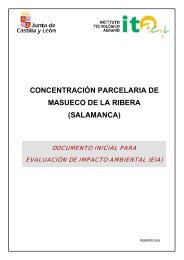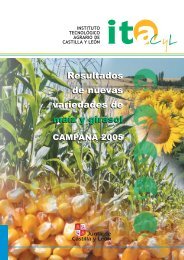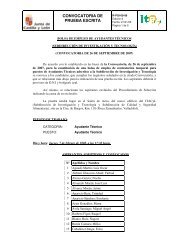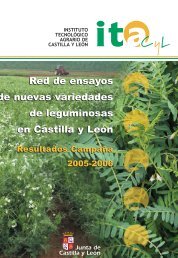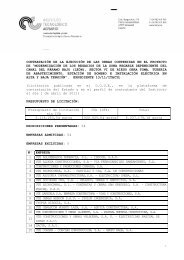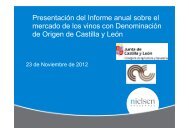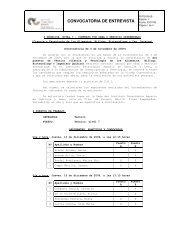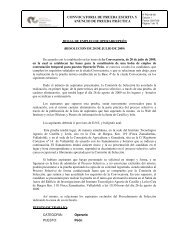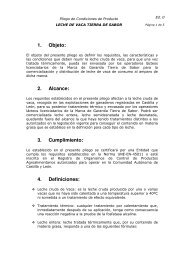Ensayos del Centro de Pruebas de Porcino: fase de cebo ... - ITACyL
Ensayos del Centro de Pruebas de Porcino: fase de cebo ... - ITACyL
Ensayos del Centro de Pruebas de Porcino: fase de cebo ... - ITACyL
You also want an ePaper? Increase the reach of your titles
YUMPU automatically turns print PDFs into web optimized ePapers that Google loves.
Análisis estadístico<br />
Los datos fueron analizados por el procedimiento<br />
GLM <strong>de</strong> SAS v. 6.12 (SAS, 1990).<br />
Para el análisis <strong>de</strong> productividad se introdujo<br />
en el mo<strong><strong>de</strong>l</strong>o el peso inicial como<br />
covariable.<br />
Resultados y discusión<br />
En la tabla 10.3. se muestra la evolución<br />
<strong><strong>de</strong>l</strong> peso <strong>de</strong> los animales en función <strong><strong>de</strong>l</strong><br />
tratamiento.<br />
TABLA 10.3. Efecto <strong><strong>de</strong>l</strong> tratamiento sobre el peso <strong>de</strong> los animales durante el período experimental.<br />
Nivel <strong>de</strong> oleico (%)<br />
23-60 kg 60-90 kg 90-125 kg<br />
Nivel <strong>de</strong><br />
Corrector (%)<br />
Sexo Tto.<br />
0 d<br />
Peso vivo, kg<br />
50 d 81 d 116 d<br />
1,5 2,3 2,3<br />
0,2<br />
0,3<br />
MC<br />
HE<br />
MC<br />
HE<br />
A<br />
B<br />
C<br />
D<br />
23,5<br />
23,5<br />
24,5<br />
22,5<br />
65,0<br />
59,4<br />
65,1<br />
63,5<br />
95,7<br />
86,3<br />
97,8<br />
90,6<br />
130,3<br />
124,1<br />
135,9<br />
124,4<br />
2,0 2,3 3,8<br />
0,2<br />
0,3<br />
MC<br />
HE<br />
MC<br />
HE<br />
E<br />
F<br />
G<br />
H<br />
23,5<br />
23,5<br />
24,5<br />
22,5<br />
61,4<br />
62,7<br />
62,8<br />
64,5<br />
91,0<br />
92,4<br />
92,7<br />
92,2<br />
124,3<br />
126,6<br />
129,1<br />
124,4<br />
3,0 3,8 3,8<br />
0,2<br />
0,3<br />
MC<br />
HE<br />
MC<br />
HE<br />
I<br />
J<br />
K<br />
L<br />
23,5<br />
23,5<br />
23,8<br />
22,5<br />
65,3<br />
63,7<br />
63,6<br />
63,0<br />
98,6<br />
95,2<br />
94,1<br />
92,1<br />
132,4<br />
130,4<br />
127,4<br />
129,7<br />
Nivel <strong>de</strong> oleico (%)<br />
23-60 kg 60-90 kg 90-125 kg<br />
Nivel <strong>de</strong><br />
Corrector (%)<br />
Sexo Tto.<br />
0 d<br />
Peso vivo, kg<br />
50 d 81 d 116 d<br />
Bajo 23,5 63,3 92,6 128,7<br />
Nivel <strong>de</strong> oleico Medio 23,5 62,9 92,1 126,1<br />
Alto 23,3 63,9 95,0 130,0<br />
Nivel <strong>de</strong> corrector<br />
0,2<br />
0,3<br />
23,5<br />
23,4<br />
62,9<br />
63,8<br />
93,2<br />
93,3<br />
128,0<br />
128,5<br />
Sexo<br />
MC<br />
HE<br />
23,9<br />
23,0<br />
63,9<br />
62,8<br />
95,0<br />
91,5<br />
129,9<br />
126,6<br />
(n=4) Sexo*Oleico*Corrector - 2,5 3,4 4,6<br />
(n=8) Sexo*Oleico; Oleico*Corrector - 1,7 2,4 3,3<br />
EEM (n=12) Sexo*Corrector - 1,4 2,0 2,7<br />
(n=16) Oleico - 1,2 1,7 2,3<br />
(n=24) Sexo; Corrector - 1,0 1,4 1,9<br />
P NS NS NS<br />
En las figuras 10.2., 10.3. y 10.4. se muestra<br />
la evolución <strong><strong>de</strong>l</strong> peso para los diferen-<br />
tes niveles <strong>de</strong> oleico y <strong>de</strong> corrector y para<br />
cada uno <strong>de</strong> los sexos, respectivamente.<br />
148 10. INCLUSIÓN DE DIFERENTES NIVELES DE ÁCIDO GRASO OLEICO Y DE CORRECTOR ...



